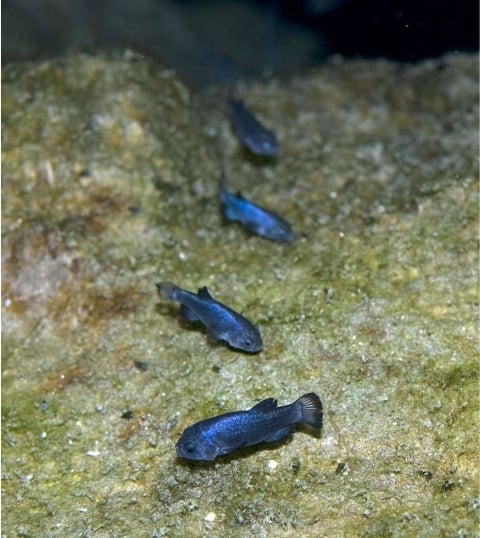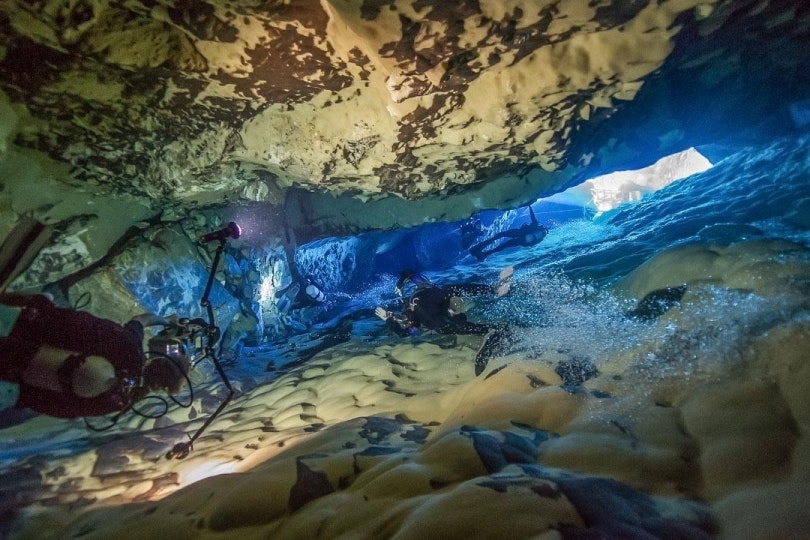The Extraordinary Lives of Death Valley's Endangered Devils Hole Pupfish

.
.
Amidst the dry cracking earth of Death Valley National Park are several springs and creeks where one may find any of 5 types of pupfish. However, even among the world’s pupfish population, some groups reign supreme. It’s the elusive history and endearing character of the Devils Hole pupfish that is particularly awe-inspiring, keeping biologists and fish fans vigilant of the population’s status.
About the Devils Hole Pupfish
The pupfish earned their name due to the playful way in which they frolic about like puppies. It’s a bright, silvery-blue, little fish with the flat head of a pike and the tiny body of a goldfish (the typical adult pupfish is 35mm). Unlike its brethren in the park, the Devils Hole pupfish have several distinctive characteristics, including its smaller size, absence of pelvic fins, low fecundity (unfortunately), and less aggressive behavior. It’s unknown whether these differences are underlying genetic divergence or simply developmental responses to the extreme conditions in Devils Hole.
Location, Location, Location
Devils Hole is an oasis within Death Valley unlike any other in the world. It is part of an extensive underground water system. Snow melt or rain percolates through the ground, entering an aquifer, and 10,000 years later, 1 molecule of water arrives.

The water in Devils Hole is a balmy 92 degrees, making it more comparable to a bath than a dip into an underwater cave and an unlikely climate for any fish to survive, let alone thrive.
Before the drop off into the cavernous depths (a 500-foot pit whose bottom has yet to be reached), sits a compact area of shallow water – the pupfish’s feeding and mating spot of choice.
Despite past efforts to create a similar artificial platform for the pupfish, as well as attempts to breed Devils Hole pupfish and hybrids in captivity, this small ledge remains the sole spawning and feeding shelf for the fish.
Devils Hole is also unique in that it acts as an unexpected indicator of seismic activity around the world. Waves have splashed up to two meters, reacting to large earthquakes as far as Japan, Indonesia, and China and demolishing the pupfish’s beloved shelf.
Conservation Efforts Today and Ongoing Research
In 1952, a presidential proclamation declared Devils Hole a unit of Death Valley National Monument (the park’s name later changed to Death Valley National Park in 1994). Then in 1967, the Devils Hole pupfish were officially listed as an endangered species. Since the 1970s, researchers and divers have made it their mission to count the population twice a year, a 2-day process with numerous dives.
Sadly, the cards aren’t stacked in this tiny fish’s favor. In the mid-1990s, the population began a steep decline, though studies cannot pinpoint the exact cause. Before 1995, the population size had regularly fluctuated between 200 fish in the spring to 300-500 fish in the fall. Since then, the numbers have dropped. The smallest count thus far has been 35 fish, despite researchers’ best attempts to propagate their population.

Confusion over the Devils Hole pupfish history also remains. Scientists have long believed that this unique group of pupfish has been isolated from Death Valley’s other pupfish populations for about 10,000-20,000 years. However, recent research suggests that the first pupfish species in Death Valley arrived just 10,000 years ago and that the Devils Hole pupfish only became isolated less than 1,000 years ago – much more recently than originally believed and much later than they were first carried into the cavern. Rather than having been left behind from a wet period when rivers and lakes converged in the desert, scientists now hypothesize that the fish may have been accidentally brought to their location by humans or birds.
The incredible living circumstances, mysterious beginnings, and delightful pup-like movements of the Devils Hole pupfish make them an exciting fish to follow. Though the population has dropped over the years, those that know the story of the pupfish remain hopeful that new strides in research will be made to prevent this unusual community from dying out. Today, they remain an example of a beloved group of animals that continue to be protected in our national parks.